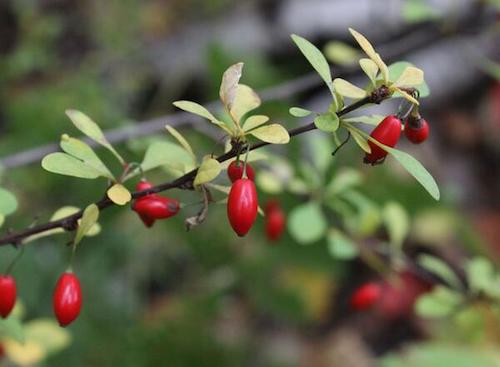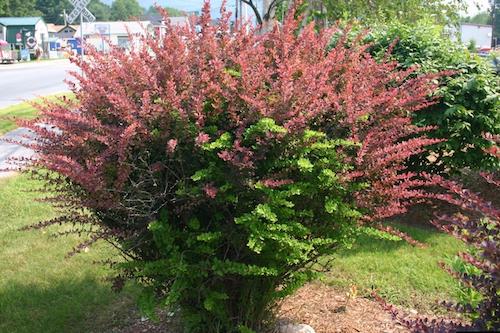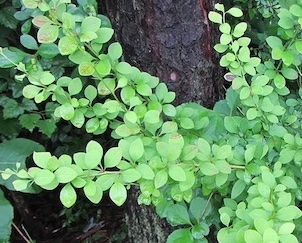Just Say No to Invasive Barberry
by Janet Scheren, Fairfax Master Gardener

Barberry berries
When the homes in my neighborhood were built more than 30 years ago, one of most popular shrubs in a landscaper’s design pallet was the barberry. These reasonably priced, evergreen shrubs produce flowers in spring and berries in fall. Even better, they come in dozens of colors, from lime green to dark burgundy — many with vibrant fall colors. Most form neat and compact mounds about 3 or 4 feet tall (90 to 120 cm) with no pruning necessary. A few varieties have a striking upright columnar form, while a few others are a little wider than tall. They work well in groups, in planters or mixed with other flowering plants, and are great for edging. If that’s not enough, they are very easy to grow in poor soil and harsh locations and need almost no attention to thrive anywhere. And that’s what makes them an invasive threat to our native woods.
It all began with the common barberry or European barberry, which was intentionally introduced to North American landscapes in the 1600s. Not only did this common variety escape cultivation and spread throughout the northern United States, but it also became problematic due to its role as a host for the destructive wheat disease, black stem rust. Despite state and federal agency eradication campaigns, populations still persist in the Northeast.

Barberry shrub form
The Japanese barberry, Berberis thunbergii, was introduced in the late 1800s as a decorative alternative to the common barberry, but it also became invasive — easily spreading into nearby forests, fields and wetlands, especially across the Northeast and Mid-Atlantic, including Virginia. Japanese barberry is now recognized as one of the most invasive plant species in the U.S., thanks to its ability to colonize and thrive in a range of environments.
Once established, the Japanese barberry creates dense thickets that prevent native plants from growing, disrupt forest regeneration and change soil conditions. Not only does it take up space, but it also actively alters its surroundings. By raising soil pH and nitrogen levels, barberry makes it harder for more acid-loving, native species to survive. These soil changes impact essential nutrient cycling processes and reduce the diversity of microbes in our soil. Thus, barberry creates an ecosystem favorable for itself, making it even harder for native plants to reestablish and thrive. In addition, Japanese barberry’s thorny branches protect it from being eaten by local herbivores like deer, putting more pressure on the remaining native plants.
One of the most concerning effects of barberry’s spread is its contribution to rising tick populations. Studies have shown that barberry thickets create a perfect environment for ticks, particularly the black-legged tick, which spreads Lyme disease. The dense, humid shade under barberry’s low branches attracts small mammals such as white-footed mice, which are primary carriers of Lyme disease. This makes Japanese barberry not only an ecological threat but also a public health concern.
Stop the Spread
The best way to control bayberry’s spread is by carefully removing any barberry plants you currently own and by not purchasing any more. If you, like me, take long walks in the woods and see errant barberries galore that have invaded from neighboring yards, start by removing seedlings as you pass them. I try to pull out any seedlings I notice, a task I can manage even while walking my dog. In addition, I’ve started taking more deliberate eradication runs each spring and fall to help remove these invasive plants from adjacent woodlands. Here are some approaches recommended by experts.

Barberry leaves
Pulling or cutting barberry plants is one of the most direct control methods. This is best done before it produces berries. Barberry can sprout from root fragments, so it’s important to remove the whole root. Be extremely careful when pulling barberry by hand because the tips of barberry spines are finer than the point of a hypodermic needle, and their silicate composition decomposes very slowly under the skin. Unfortunately, barberry germinates from seeds, which can remain viable for up to nine years in the seedbank.
Herbicides can be applied directly to cut barberry stumps, limiting the impact on surrounding vegetation. Chemical treatments are often combined with mechanical removal for greater effectiveness.
Controlled burns can reduce barberry cover. However, this is not an approach that most homeowners can safely undertake. Fortunately, burning the base of barberry plants with a propane torch also has been shown to be an effective method of control. When weather conditions permit and the ground is moist enough to reduce the risk of fire spreading, hold flame on the plant base for 15 to 20 seconds.
Native Alternatives to Japanese Barberry
Replacing barberry with native plants is the best way to prevent its spread and protect local ecosystems. Fortunately, there are many native shrubs that offer the same aesthetic appeal without the invasive potential. Here are a few alternatives.
Inkberry Holly (Ilex glabra) is a versatile evergreen shrub, that is excellent for hedging, landscape beds or screening and can be trimmed to maintain a compact shape.
Red Chokeberry (Aronia arbutifolia) is a native shrub that offers brilliant autumn foliage and clusters of white flowers in spring. Its red berries add winter interest and provide food for local birds.
Winterberry Holly (Ilex verticillata) has bright red berries that last from fall through winter, making it an attractive choice for borders and natural screens. It’s hardy and adaptable, thriving in wet soils.
Gray Dogwood (Cornus racemosa) provides spring blooms and white fruit, with stunning red-to-purple fall foliage.
Virginia Sweetspire (Itea virginica) is known for its fragrant, bottlebrush-shaped white flowers and rich fall color. This native shrub is resilient and can handle wet soils.
Dwarf Fothergilla (Fothergilla gardenii) offers blue-green leaves and striking orange-to-maroon fall tones, providing year-round visual interest.
-
Resources
- Invasive Species Management: Common and Japanese Barberry, Ashley Kulhanek, Tim McDermott and Kathy Smith, Ohio State University Extension
- Invasive Japanese Barberry, University of Illinois Extension
- Japanese Barberry, Art Gover, David Jackson, Sarah Wurzbacher and Skylure Templeton, Penn State Extension